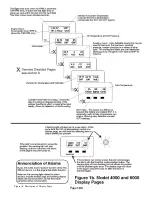
Page
105
Congratulations on your purchase of Grand Rapids Technologies' Engine Information System (EIS). We are pleased that
you have chosen our product to meet your aircraft instrumentation needs. You will find this system will enhance your
flying pleasure while increasing your level of safety.
1.
Read This First!
Note for those upgrading the software with a new computer chip. After installing the chip, it may be initialized
to factory default settings by pressing and holding the right button when turning the instrument on. After a delay
of a few seconds, this will set the user-defined pages to the factory configuration.
Advice Before Starting Your Installation: Three steps to make your installation easier.
Step 1. Determine how you would like to arrange your EGT/CHT connections. The EGT/CHT inputs are
numbered 1-4 (1-6 for the Model 6000). You may simply connect EGT1 & CHT1 to cylinder number one
(according to the engine manufacturer’s cylinder numbering). This is common, and works well. For four-
cylinder engines there is also an alternate method. You may wish to connect the EGTs and CHTs so they
correspond to their position on the digital display pages. That is, connecting EGT 1 & CHT 1 to the front left
cylinder (since it appear on the top left position of display page), EGT 2 & CHT 2 to the front right cylinder
(since it appears on the top right position of the display page), and so on. (Figure 1 illustrates the position of the
data on the display pages.) Either option works well, although personally the latter method is easiest. The main
point is to make sure you know which cylinder corresponds to each of the readings on the instrument so that you
will perform maintenance on the correct cylinder when it becomes necessary.
Step 2. Plan which functions you will wire to each of the 4 auxiliary inputs. Recall that manifold pressure, fuel
pressure, fuel level, vacuum, coolant pressure (and any others that do not have a dedicated input to the
instrument) must be connected through the auxiliary inputs. (The auxiliary inputs may be used for other
functions also, but these are the most common uses.) The only significant consideration concerns the position of
the auxiliary input functions on the labeled pages. Referring to figure 1b, you will note that auxiliary 1, 2, & 3
appear on page 12, and auxiliary 4 appears on the next page. You may prefer to see two or three auxiliary
functions on the same page (for example, left and right fuel levels). This will require wiring them to the first
three auxiliary inputs.
Step 3. Remember that you have complete control over what will be displayed on the two combination pages,
and the digital data displayed on the bar graph pages. You will find this useful for conveniently displaying the
exact data you would like available during your flight
…now on to the installation!
2.
An Overview of Installation & Setup
Installation of the EIS includes the physical mounting of the instrument into the airplane’s instrument panel,
making the electrical connections from the pre-wired cables to the various sensors, and finally setting entries in
the instrument to customize your instrument for your installation. The first two steps are quite obvious. The
entries made to the instrument for your installation tells the instrument such things as how many pulses per
revolution of your engine, units (Fahrenheit or Celsius), etc.
Following these steps, operation of the instrument will be verified by applying power to it. Finally, you will set
your engine limits, and customize the display pages to your liking.
During flight you will use the leaning functions to accurately lean your engine. During the cruise
portion of your flight you will use the tracking functions to continuously monitor your engine for even
momentary signs of developing engine problems. Now let’s get started with the installation by turning
to the section “Installation” which begins on page 110
3.
Using the Engine Information System
Refer to figure 1 for a description of the various display pages, and to figure 2 for an illustration of the
use of the EIS from panel keys to control the operation of the instrument.
Содержание 912 Dragonfly
Страница 3: ...Page 2 ...
Страница 4: ...Page 3 ...
Страница 5: ...Page 4 ...
Страница 25: ...Page 24 Drawing 1 ...
Страница 27: ...Page 26 Drawing 2 ...
Страница 29: ...Page 28 Drawing 3 ...
Страница 31: ...Page 30 Drawing 4 ...
Страница 33: ...Page 32 Drawing 5 ...
Страница 35: ...Page 34 Drawing 6 ...
Страница 37: ...Page 36 Note for Hydraulic Brakes see Appendix B Drawing 7 ...
Страница 39: ...Page 38 Drawing 8 ...
Страница 41: ...Page 40 Drawing 9 ...
Страница 43: ...Page 42 Drawing 10 ...
Страница 45: ...Page 44 Drawing 11 ...
Страница 47: ...Page 46 Drawings 12A 12B ...
Страница 49: ...Page 48 Drawing 13 ...
Страница 51: ...Page 50 Drawing 14 ...
Страница 53: ...Page 52 Drawing 15 ...
Страница 55: ...Page 54 Drawing 16 ...
Страница 57: ...Page 56 Drawing 17 ...
Страница 59: ...Page 58 Drawing 18 ...
Страница 61: ...Page 60 Drawing 19 ...
Страница 63: ...Page 62 Drawing 20 ...
Страница 65: ...Page 64 Drawing 21 ...
Страница 67: ...Page 66 Drawing 22 ...
Страница 69: ...Page 68 Drawing 23 ...
Страница 71: ...Page 70 Drawing 24 ...
Страница 73: ...Page 72 Drawing 25 ...
Страница 75: ...Page 74 Drawing 26 ...
Страница 77: ...Page 76 Drawing 27 ...
Страница 79: ...Page 78 Wiring1 jpg Drawing 28a ...
Страница 80: ...Page 79 Wiring2 jpg Drawing 28b ...
Страница 81: ...Page 80 elecLights jpg Drawing 28c ...
Страница 83: ...Page 82 Drawing 29 ...
Страница 85: ...Page 84 Drawing 30 ...
Страница 92: ...Page 91 Appendix B Brakes Manual for BX1320 BX1000 Appendix B Page 1 ...
Страница 93: ...Page 92 Appendix B Page 2 ...
Страница 94: ...Page 93 Appendix B Page 3 ...
Страница 96: ...Page 95 Appendix B Page 5 ...
Страница 97: ...Page 96 Appendix B Page 6 ...
Страница 98: ...Page 97 Appendix B Page 7 ...
Страница 104: ...Page 103 Figure 1a Description of Display Pages ...
Страница 105: ...Page 104 Figure 1b Description of Display Pages ...
Страница 138: ...Page 137 Appendix C EIS 4000 912 914 ...
Страница 139: ...Page 138 Appendix C EIS 4000 912 914 ...
Страница 140: ...Page 139 Appendix C EIS 4000 912 914 ...
Страница 141: ...Page 140 Appendix C EIS 4000 912 914 End Appendix C ...
Страница 155: ...Page 154 Appendix E2 Powerfin Prop Page 2 ...
Страница 156: ...Page 155 Appendix E2 Powerfin Prop Page 3 ...
Страница 157: ...Page 156 Appendix E2 Powerfin Prop Page 4 ...
Страница 158: ...Page 157 Appendix E2 Powerfin Prop Page 5 ...
Страница 159: ...Page 158 Appendix E2 Powerfin Prop Page 6 ...
Страница 160: ...Page 159 Appendix E2 Powerfin Prop Page 7 ...
Страница 161: ...Page 160 Appendix E2 Powerfin Prop Page 8 ...
Страница 162: ...Page 161 Appendix E2 Powerfin Prop Page 9 ...
Страница 163: ...Page 162 Appendix E2 Powerfin Prop Page 10 ...
Страница 164: ...Page 163 Appendix E2 Powerfin Prop Page 11 End of Appendix E2 ...
Страница 187: ...Page 186 By Memphis Soaring FIGURE 3 Common Signals ...






























